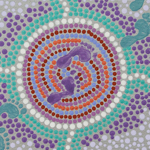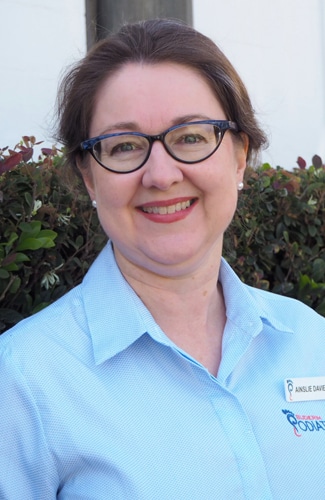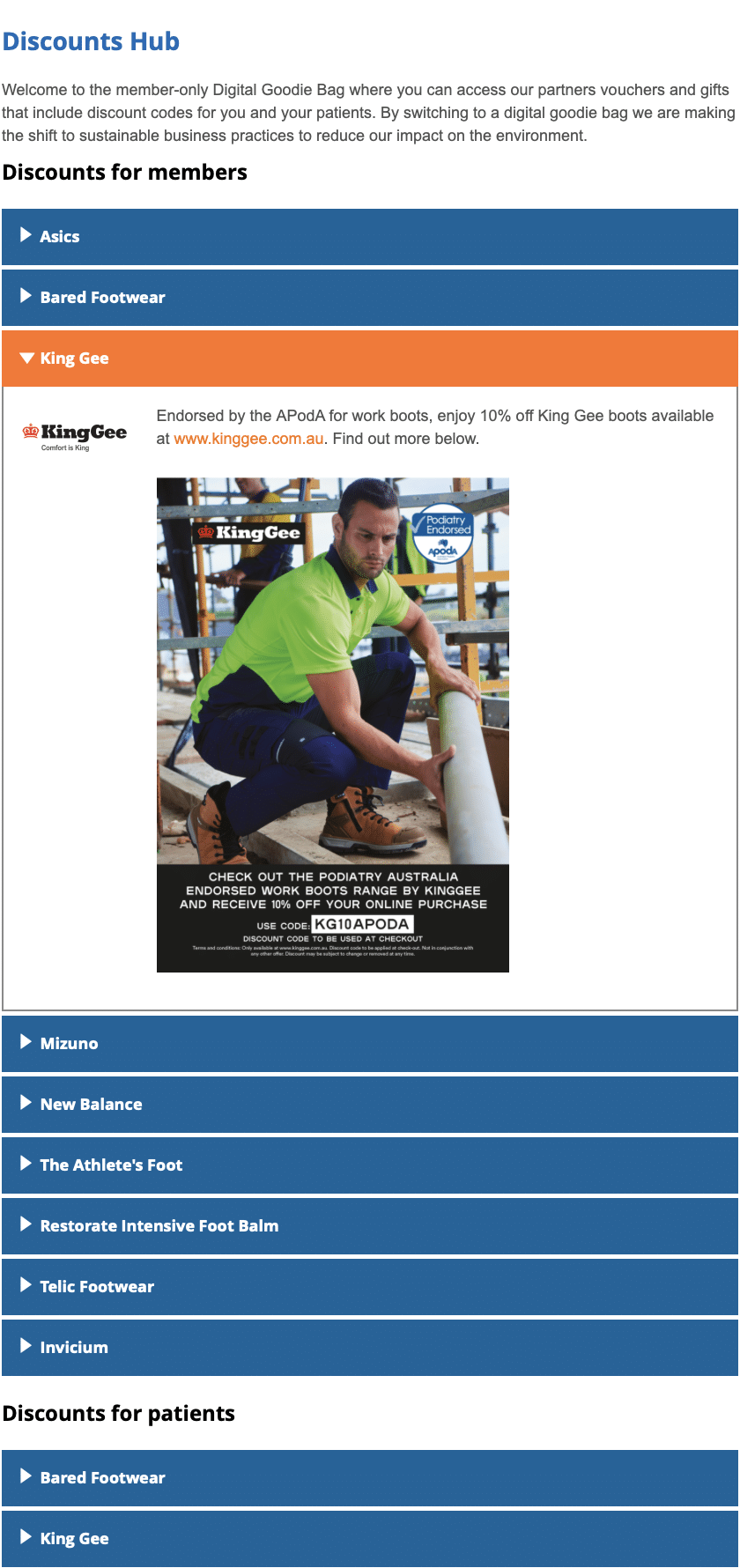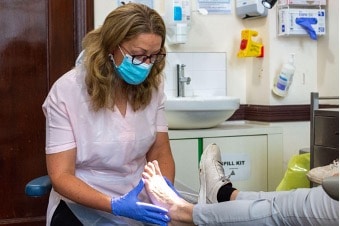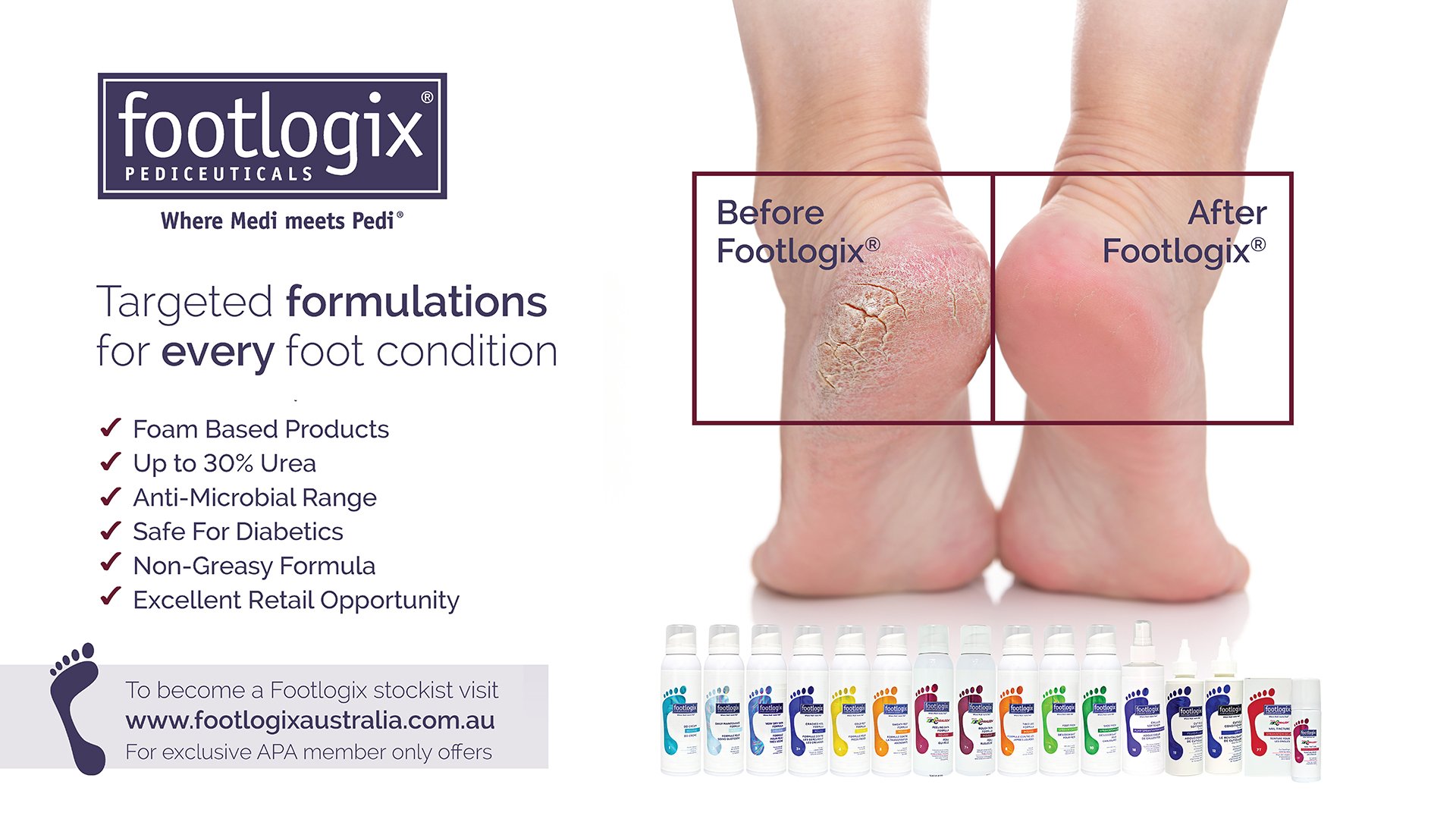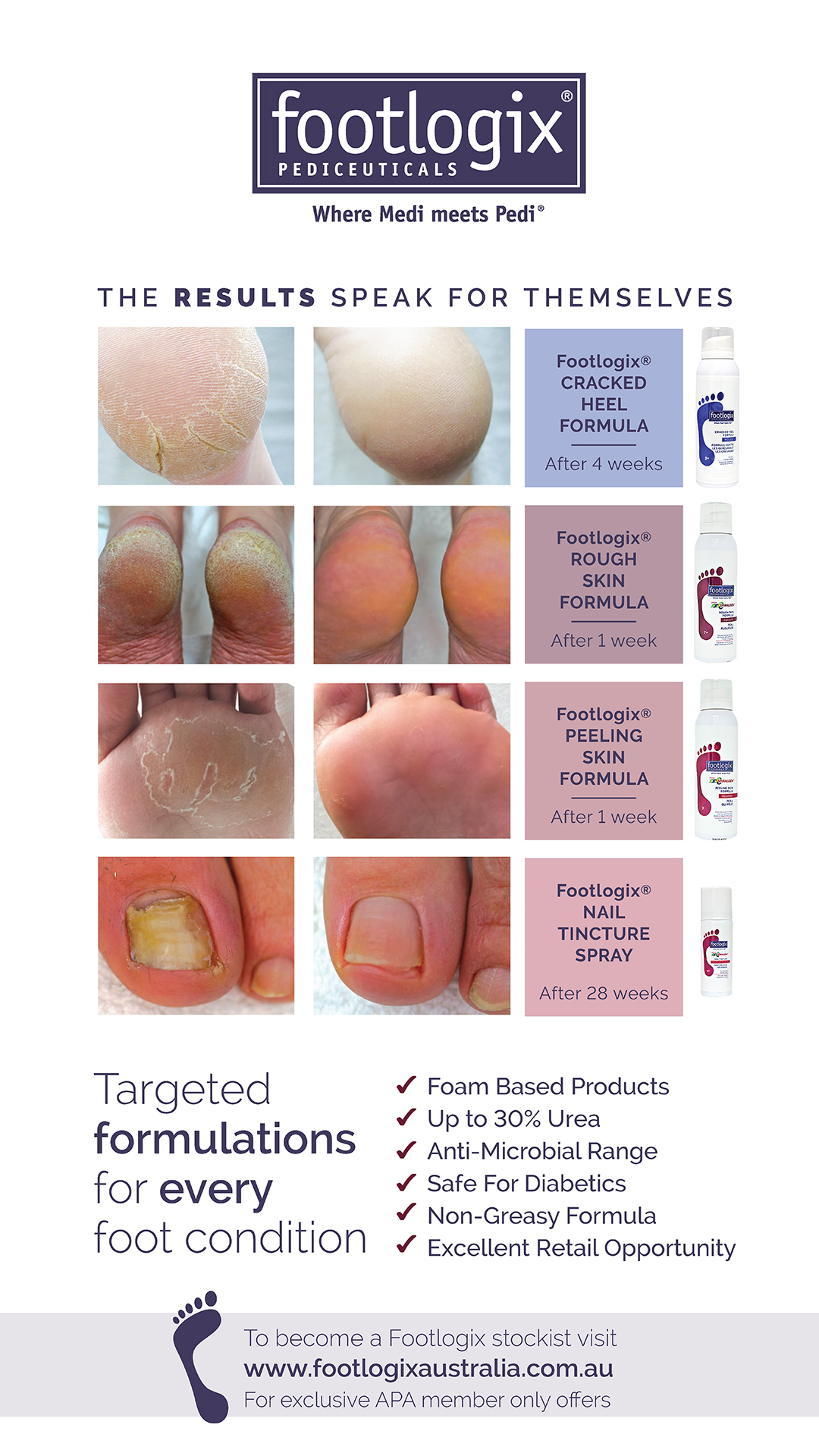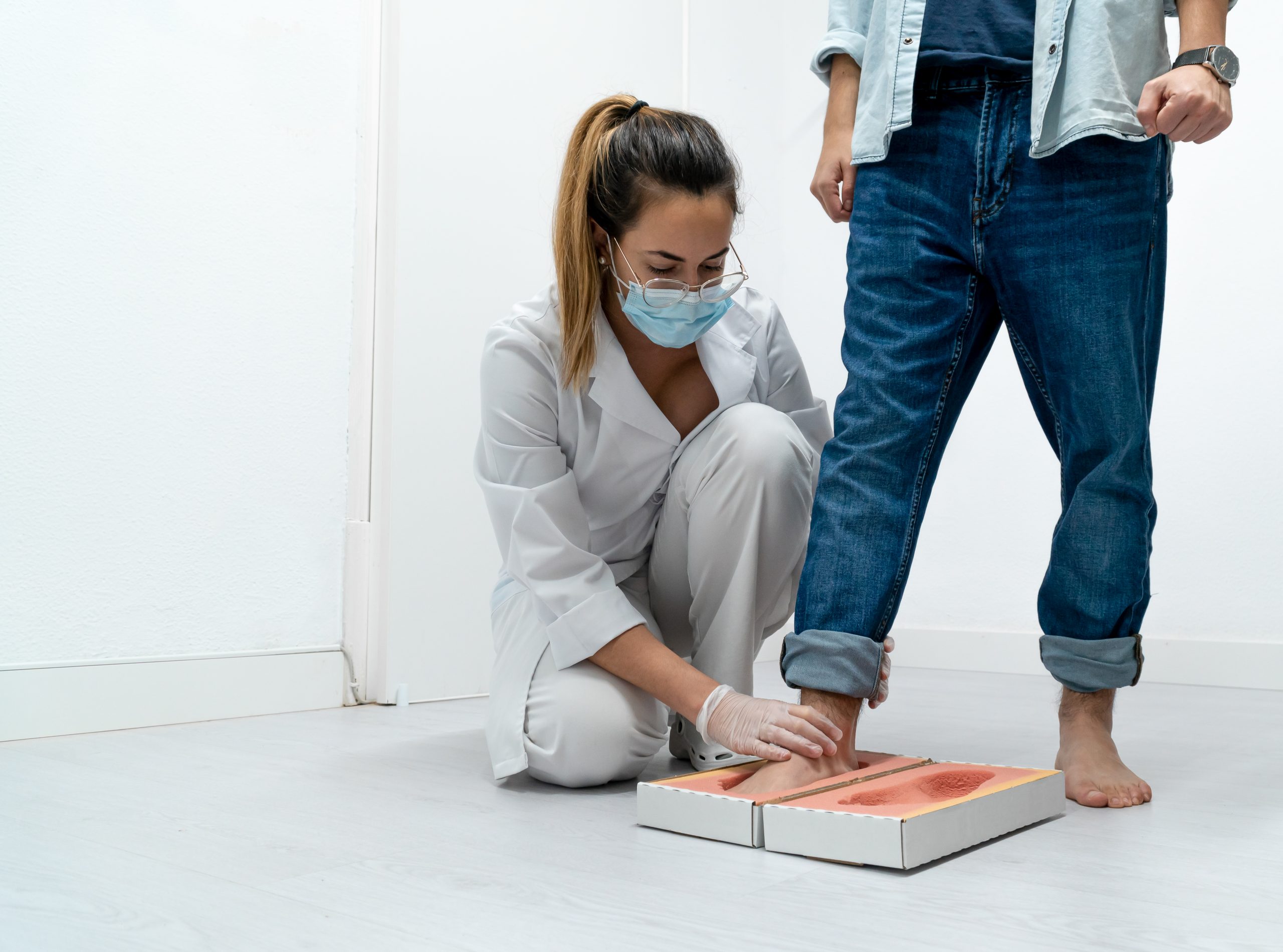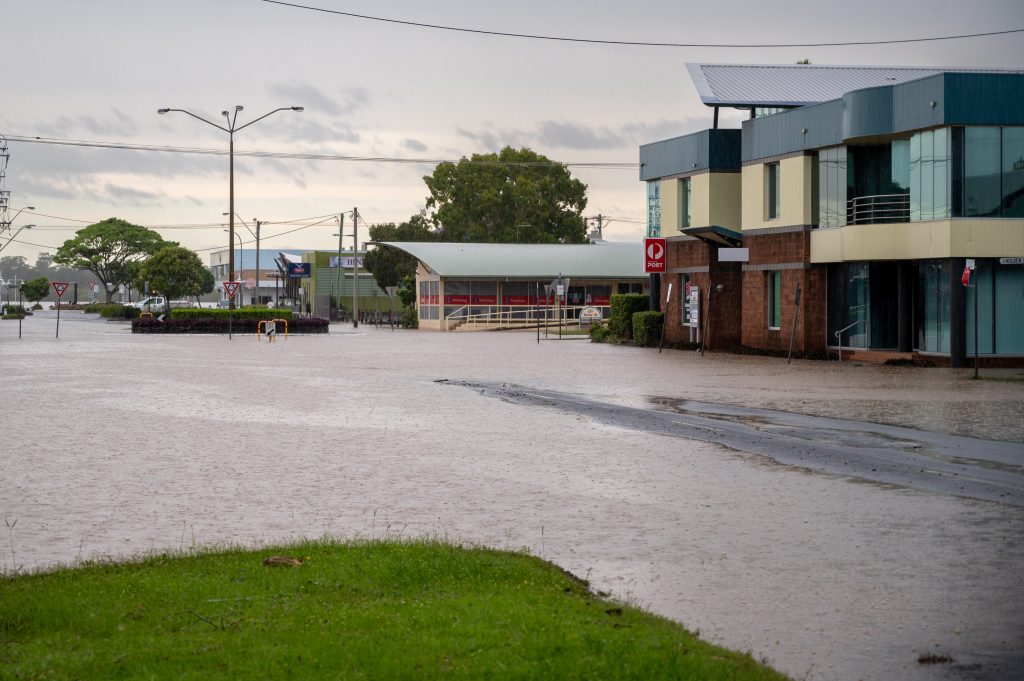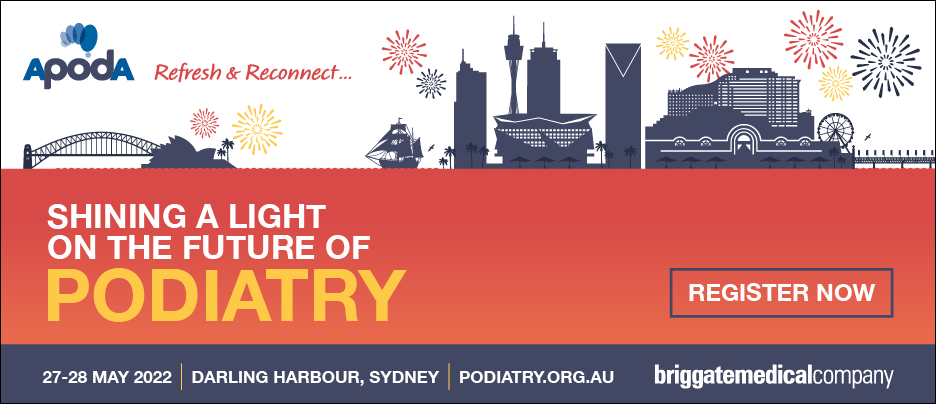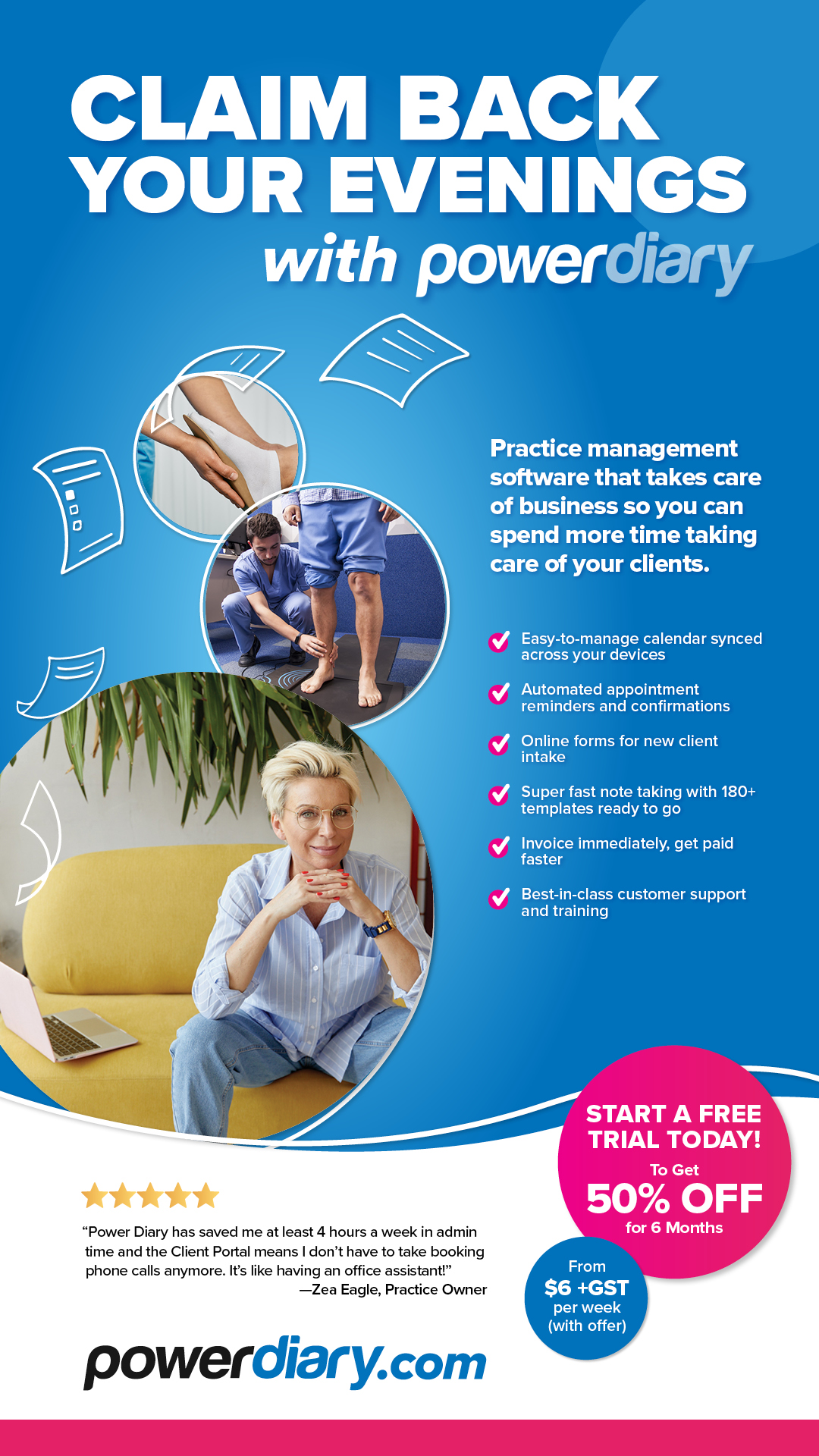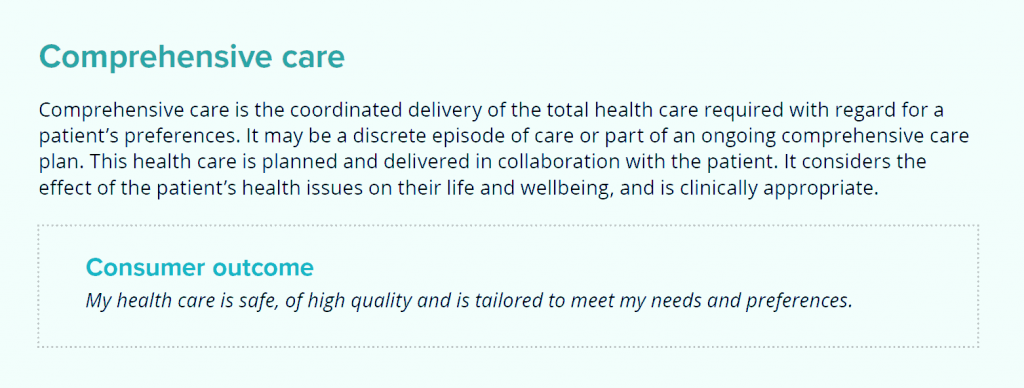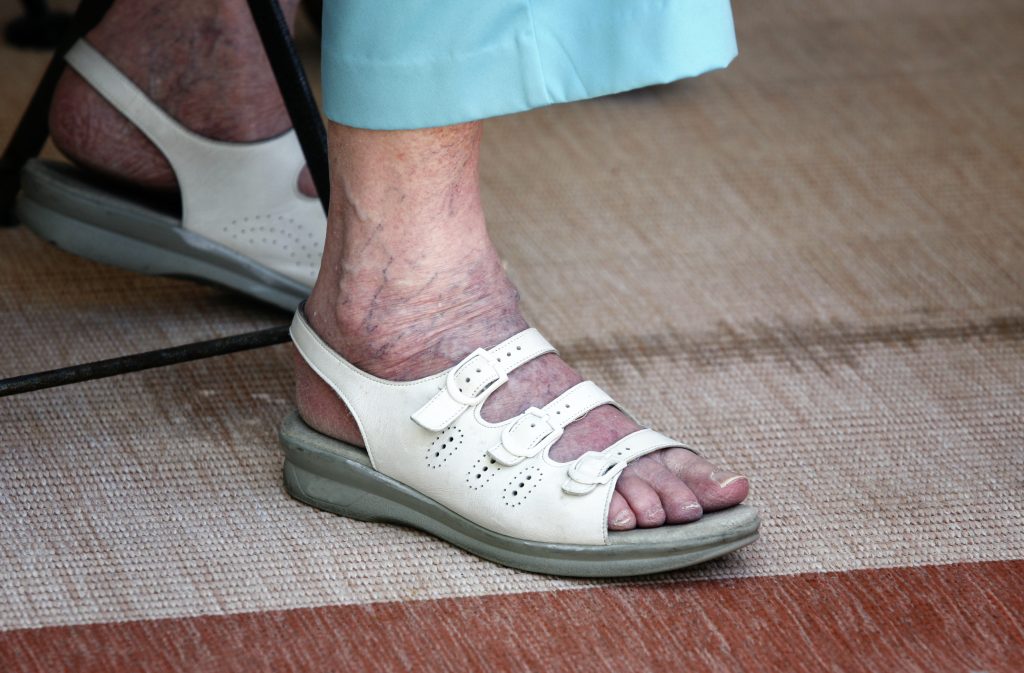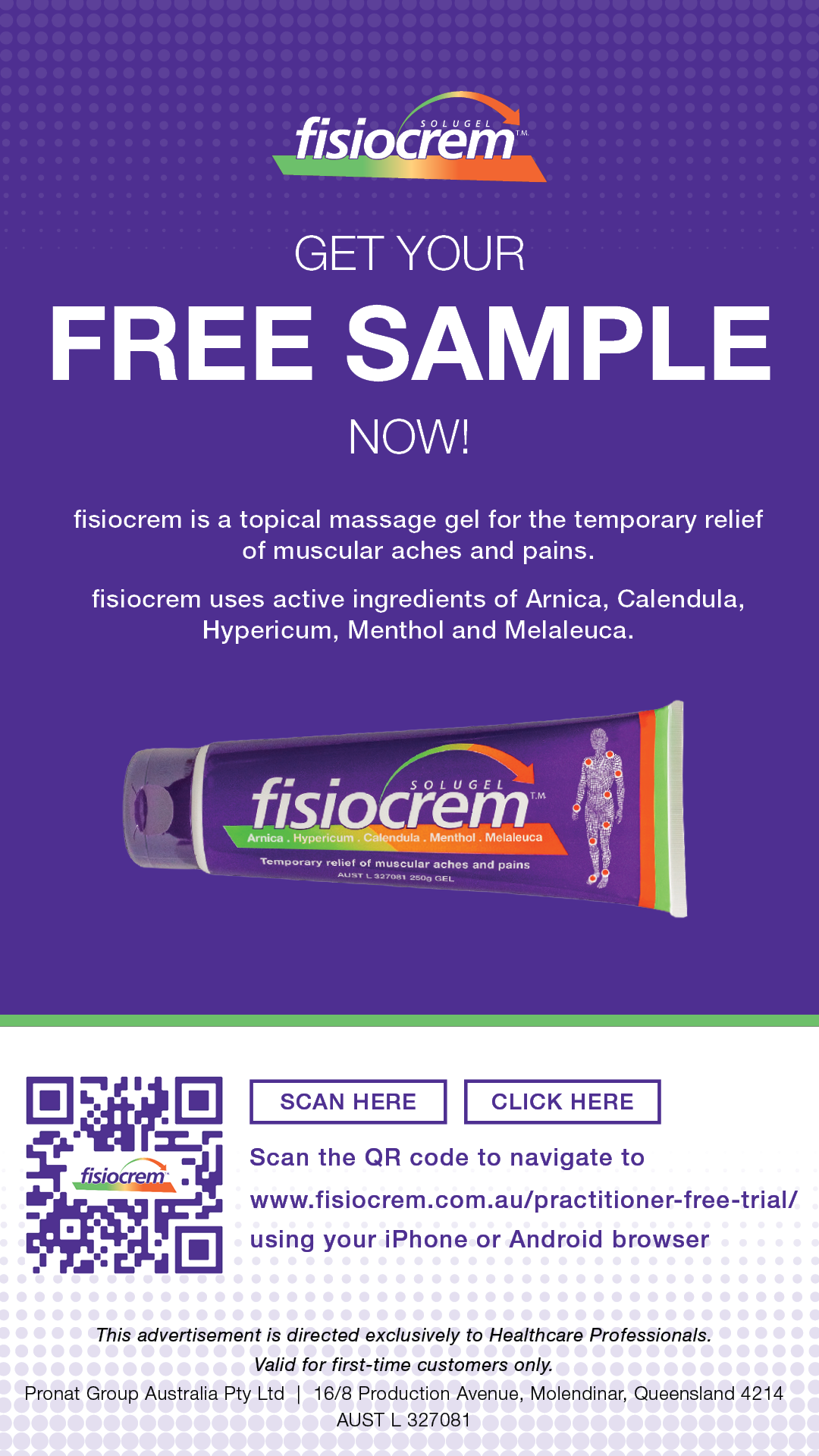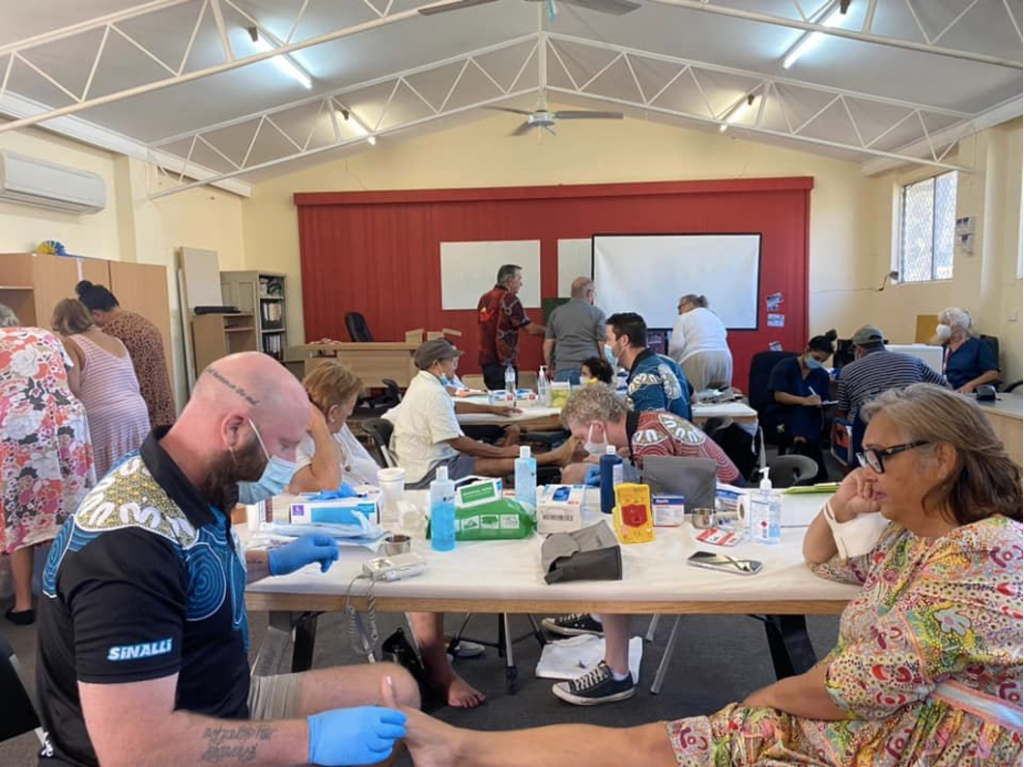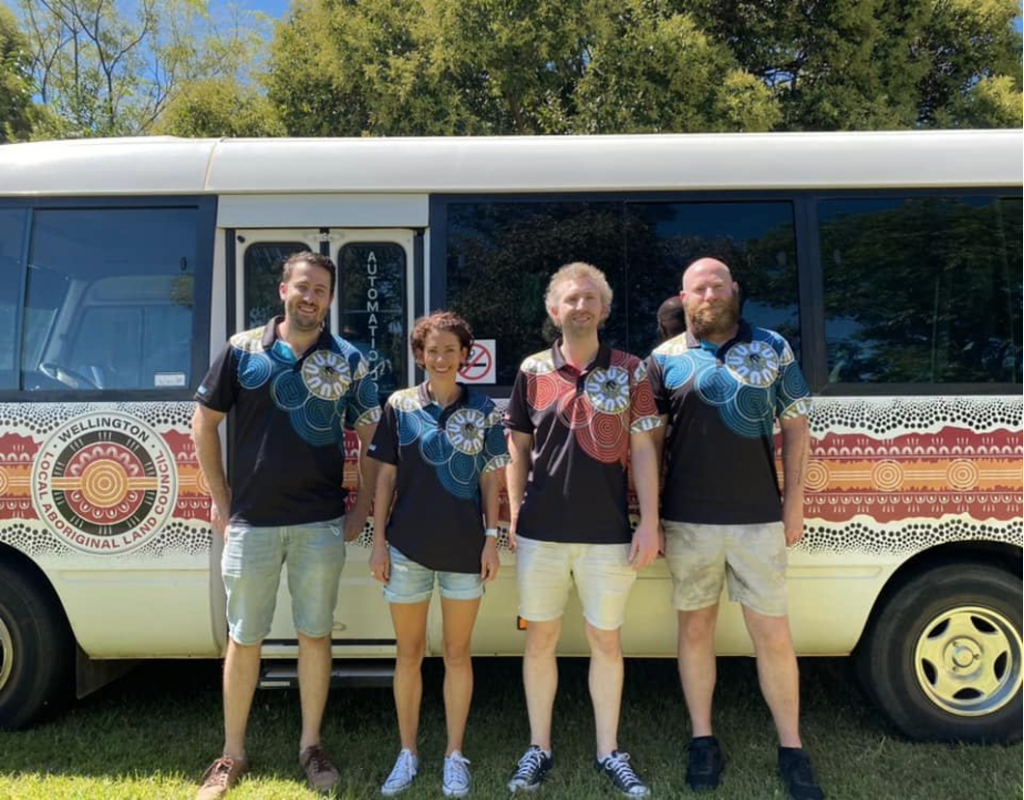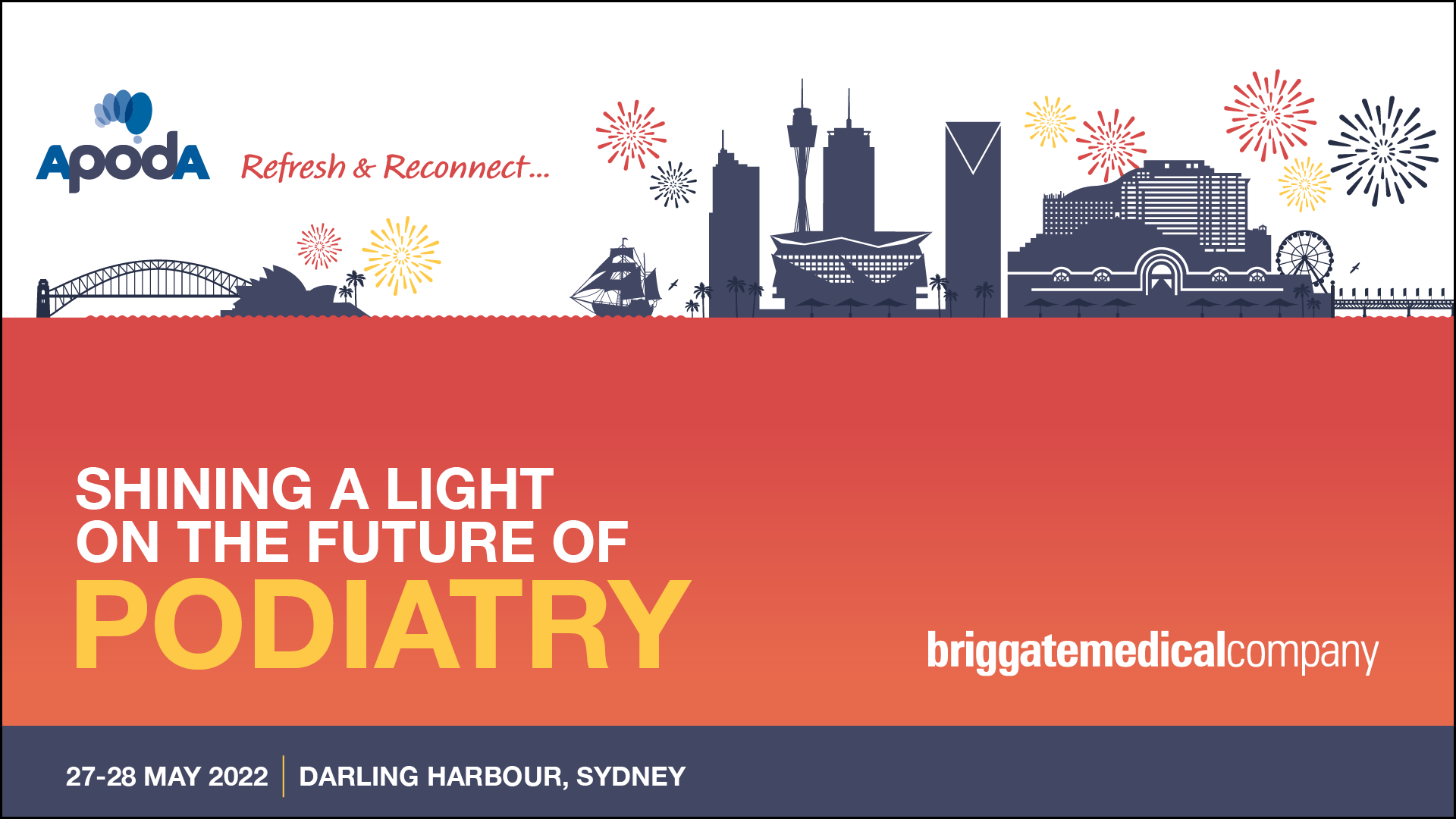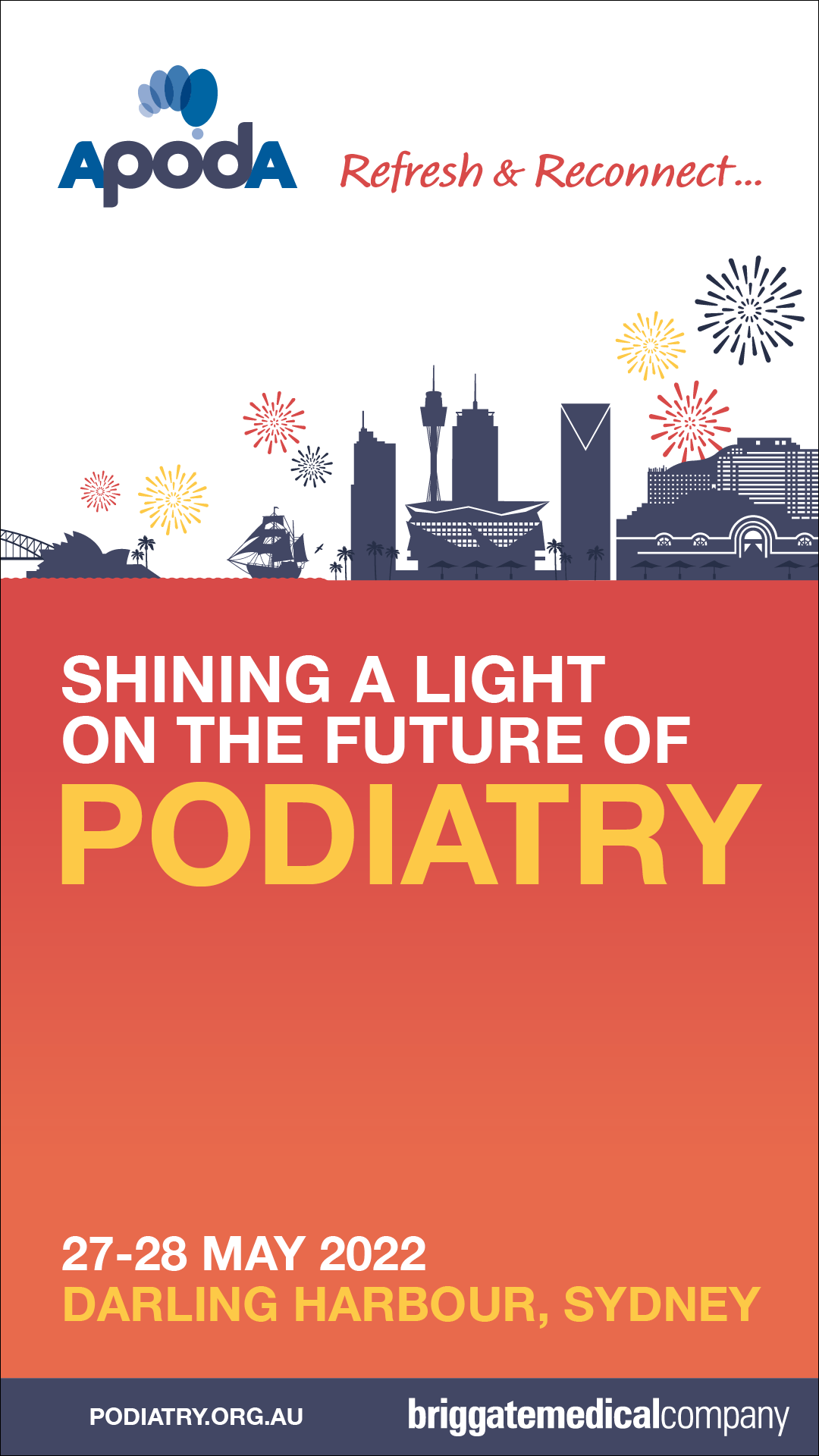
Don’t forget to check out the Footwear Hub!
Have you been on our Footwear Hub lately? There are a stack of discounts ready and waiting for you and your patients!
The APodA Footwear Hub brings a range of discounts to you and your patients. Simply log into our website as a member and scroll down in ‘Member Resources’ to ‘Footwear Hub’.
Whether you are searching for a pair of new shoes, looking for patient-facing resources to print off and hang in your clinic, or wanting to pass on some great patient discounts – it’s all here.
Brands such as Asics, Bared Footwear, King Gee, Mizuno, New Balance, The Athlete’s Foot, Telic Footwear, Restorate Intense Balm and Invicium have got behind this program to offer a range of discounts which can be immediately activated.
Head to the Footwear Hub to take a look, and don’t forget to share the patient discounts too!

Improving foot health of people experiencing homelessness
A recently published foot health study shines a light on the role of community health in improving the foot health of people who are homeless.
Little is known about the foot and ankle problems of people experiencing homelessness, but a recently published study has shed light on this often-overlooked public health issue.
Nearly 300 patients experiencing homelessness were the focus of this study, which examined the free podiatry program run by Victorian community health organisation, cohealth. The program operates via a mix of outreach and site-based services. This study analysed different types of foot health presentations and the most effective ways to reach these clients. Here’s what was found, with a link to the full paper here.
Key findings
- Just over half the patients (52.8%) were attending a podiatry service for the first time.
- Nearly half of people (45.2%) who accessed this service, whether via outreach or on site, were sleeping rough at the time.
- Over one third (32.2%) were in unstable or insecure housing and nearly a quarter (22.6%) were recently housed.
- Over half of the patients seen by the cohealth podiatry team had inadequate footwear and nearly one in five (18%) required acute wound care.
- Publicly-funded, community-based podiatry services that use an outreach model can address the foot and ankle health of people who might otherwise not access podiatry services.
- Footcare can be the ‘gateway’ that connects people to other supports and services – such as housing, drug and alcohol treatment, mental health care and community programs.
“Everyone has the right to live free of pain, and to have access to high-quality health care,” says cohealth outreach podiatrist, Rebecca Mannix. “Having flexible, adaptable services that are designed with clients is really important so that they get the healthcare they need quickly and not wait until problems become emergencies.”
Full findings appear in the recently published paper here.
CASE STUDY: Lachie’s story
This case study illustrates the value of community health services when treating a person like Lachie who has cycled through homelessness for most of his adult life, and has a range of health challenges.
A key feature of the community health model is this capacity to respond to a person’s range of needs beyond the service they may have come in for. This is done by building trust with clients such as Lachie, as podiatrist Rebecca Mannix explains.
“Lachie has had bad experiences with many services and has been banned for a few due to some of his reactions and behaviours stemming from his brain injury, but we’ve been able to work with him and he comes to see us when he needs something,” says Rebecca. “We helped him to apply for NDIS when this started and his support worker here helped with that transition as much as possible. Although I’m here to look after his feet, the cohealth team works together to make sure his holistic health needs are met – social, mental and physical,” she says.
Lachie also shares his experiences so far: “People say your brain controls your body,” he says. “But your toes control a lot more than you think. You’re always on your toes. And for someone like me, I’m on my feet a lot, walking a lot. I had been complaining about my feet being sore. I had corns and they were uncomfortable to walk on – I’d be walking down the street and step on the wrong angle, and I’d yell out in pain,” he said.
“Also, my feet were stinking because my nails were so long,” Lachie continues. “I didn’t know that was the reason they smelled at the time – germs get trapped under the nails. Someone put me onto cohealth and I met Bec (Rebecca). She helped me by getting my toes done. And getting me some reliable shoes. Bec understands the way you walk. I had been told to stop walking around so much because I was burning through too many shoes. It’s the only podiatrist I’ve ever used. I’ve never used one before. I wouldn’t know how.”
To find out more about cohealth’s support initiatives, head here.
Interested in reading more about podiatry-based charities making a difference? Head to STRIDE’s regular Footscape update here.
What people wish they had known before their amputation

The opportunity for podiatry
The onset of the COVID pandemic has brought about a renewed interest in Australian school leavers wanting to enter the healthcare profession, as a recent study shows.
A survey of 5,000 young people reveals that Australian jobseekers want to work in healthcare more than any other sector. The survey was conducted by career advice website Skillsroad across November to December 2021, and it was backed by Business Australia and several chambers of commerce.
It is believed that extensive media coverage brought on by the pandemic has highlighted healthcare as an attractive career option, even creating what has been coined the ‘rockstar effect’, given the daily news conferences featuring chief health officers and other medical advisors.
Business NSW chief executive Daniel Hunter explains. “During the pandemic, we’ve seen some of these health sectors ‘up in lights’ which you could call the rock-star effect; seeing high-profile people like Dr Kerry Chant I think attracts people into the industry,’ he said.
“The findings may give some hope to the healthcare sector which has been struggling under the weight of staffing shortages and pandemic burnout.
“It’s an attractive industry because it also has meaning as you are helping people in their time of need and young people are looking for that sense of purpose in their careers.”
While podiatry programs currently experience lower uptake than other university-based allied health programs at university, such as physiotherapy, there is an enormous opportunity in this widespread interest in the health profession.
In this month’s ACPD update, Associate Professor Caroline Robinson explains that many would-be physiotherapists who study podiatry, intending to switch across, often remain in podiatry studies after the first-year. Not only this but the growth in the number of registered podiatrists from December 2020 to December 2021 was higher than the proportional increase in registered physiotherapists during the same period (5.2% registered podiatrists compared with 3% registered physiotherapists).
To read the full article by Caroline Robinson, on behalf of the Australian Council of Podiatry Deans (ACPD), head here.

Is your clinic affected by the recent floods?
If your clinic has been affected by the recent floods that hit the east coast of Australia, here are some avenues of support to explore.
If you have been affected by the recent floods, you may already be aware of the immediate health support that has been made available. Of particular relevance to our members is the $4.7 million provided by the Australian Government to ensure continuity of affected primary health services. You can find out about this support here. More broadly, $35.9 million will be rolled out across affected areas in Queensland and NSW over a two year period, which you can read more on here.
The North Quay ferry terminal, Brisbane river floods, February, 2022.
Telehealth has also been taken into consideration, with an exemption made to normal Medicare Benefits Schedule (MBS) rules to ensure that people in flood-affected regions don’t need to have an existing relationship with a GP or other medical practitioner to access MBS-subsidised telehealth services (video and phone). While this may not directly impact podiatrists, it does increase likely activity in allied healthcare referral networks. You can read more about this here.
Ballina NSW, during the 2022 floods.
If you live in Lismore or its surrounding areas, head here to read updates on specific government interventions being provided to healthcare providers and the general public in these flood-affected areas. Further information on business support for those affected more broadly by the floods across NSW or Queensland can also be found here and here.
Need more advice? The APodA team is available to answer any questions at info@podiatry.org.au or (03) 9416 3111.
Entrepreneurial opportunities for podiatrists

Are you going to Refresh and Reconnect in Sydney?
Are you going to Refresh and Reconnect in Sydney during May? Here’s why you should consider it!
As we settle into 2022 many of us are finally able to refocus on what is important in our own career pathways and the wider podiatry profession. Questions start to emerge that can only be answered through collaboration, such as: ‘What plans exist for the future of the podiatry profession in light of ongoing industry impacts?’ Or: ‘How will new technology shape, disrupt or support the health landscape – and how will these changes impact us as podiatrists, and our patients and communities?”
These are just some of the conversations we’ll be sharing at our upcoming Sydney ‘Refresh and Reconnect’ event, which runs across 27 to 28 May this year in Darling Harbour.
‘Shining a light on the future of podiatry’ is set to tackle the big issues we all face, such as future economic, social and technological shifts, and their impact on the role of podiatrists, alongside a review of changing service delivery models and their future relevance.
Leading these discussions is a range of future-focussed leaders, researchers, and clinicians who will share their insights into impending global changes; alongside how our profession can prepare for these inevitable shifts (and major changes). Together we will discuss the role of innovation in models of care, different funding systems, changing clinical standards and new technology developments for clinicians.
Be part of the next revolution within the podiatry profession by becoming part of the ‘Refresh and Reconnect’ event in Sydney.
Let’s pause together to shine the light on the future of podiatry, for everyone’s sake.
Want to register? Head here.
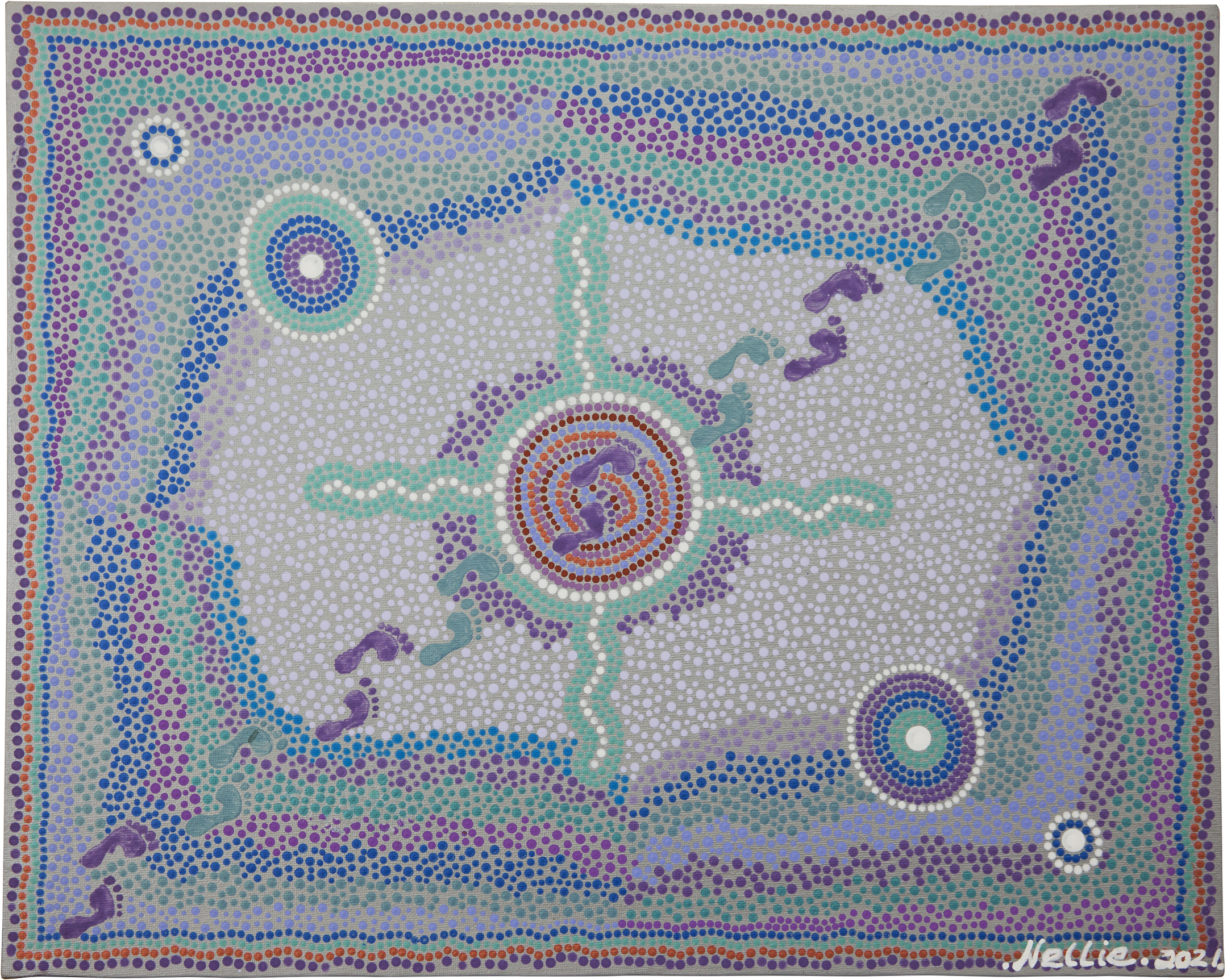
Improve cultural safety: ask a simple question

James is a podiatry graduate who has worked in public and private settings in Victoria, New South Wales and Tasmania, and he now lectures at La Trobe University within the discipline of podiatry. James is also a current University of Newcastle PhD candidate, involved in research giving First Nations voice to foot health education, and the developing, delivering, and evaluating of cultural safety education for undergraduate podiatry students.
Providing culturally safe podiatry care is a professional capability, let’s look at where it starts. Here are some questions to self-reflect on first of all.
Are you aware whether the patients you work with are Aboriginal and/or Torres Strait Islander? If not, why not? And if not, how can you deliver culturally safe care for First Nations Peoples without accounting for cultural differences?
Now start with this question
A starting point in delivering culturally safe podiatry care is to simply ask clients: ‘Are you of Aboriginal and/or Torres Strait Islander origin?’
This may be asked as an individual podiatrist or by the organisation or business within which you work.
Why is asking this question so important?
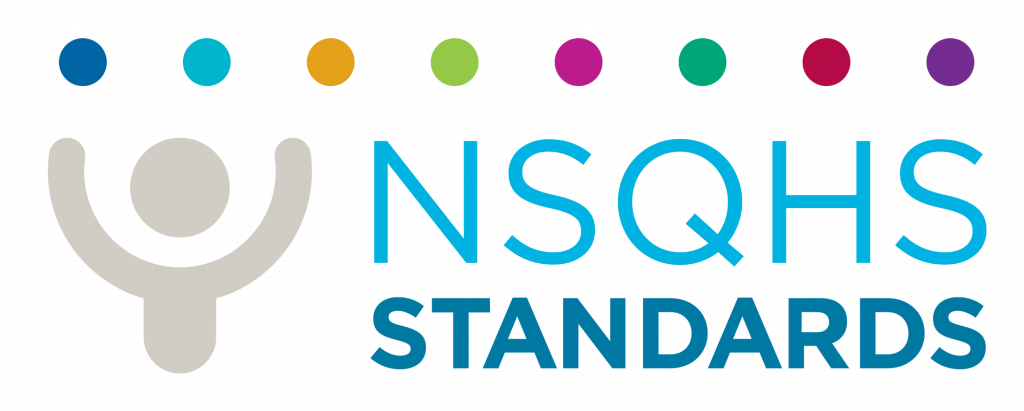
In fact, ‘Action 5.08’ of the NSQHS requires that, ‘The health service organisation has processes to routinely ask patients if they identify as being of Aboriginal and/or Torres Strait Islander origin, and to record this information in administrative and clinical information systems.’
Added to this advice, the below is taken directly from page 36 of the National Safety and Quality Primary and Community Healthcare Standards (NSQPCHS).
On the following page of this document (‘Action 3.22’), the National Safety and Quality Primary and Community Healthcare Standards requires healthcare services to have processes that:
- Routinely ask if a patient is of Aboriginal and/or Torres Strait Islander origin
- Record this information in the patient’s healthcare record
- Use this information to optimise the planning and delivery of health care
So, asking this question is important not just because it respects the patient and wider communities, but also because it reflects government guidelines that all healthcare providers should be aware of, and follow.
In the next issue of STRIDE, we will follow up with further cultural safety considerations to bear in mind when asking patients or clients if they are of Aboriginal and/or Torres Strait Islander origin.
In the meantime, the following resources may aid your own improvements when it comes to clinical governance and cultural safety:
- Australian Institute of Health and Welfare brochure for staff and fact sheet for patients
- Australian Institute of Health and Welfare 2010. National best practice guidelines for collecting Indigenous status in health data sets. Cat. no. IHW 29. Canberra: AIHW. Accessed here
- The Royal Australian College of General Practitioners (2010) Identification of Aboriginal and Torres Strait Islander people in Australian general practice accessed here
- The User Guide for Aboriginal and Torres Strait Islander Health accessed here .
How does the NSQHS fit into the bigger podiatry picture?
Here’s a run down of the structures that surround it.
- First of all, the Podiatry Accreditation Committee is responsible for developing professional and accreditation standards for approval by the Podiatry Board of Australia, and for maintaining such standards. Both the Committee and the Board comply with legal, regulatory, and professional requirements, responsibilities, and guidelines, including the Australian Commission on Safety and Quality in Health Care (ACSQHC).
- Second, the ACSQHC is a government agency that leads and coordinates national improvements in safety and quality in health care across Australia. Their aim is to support healthcare professionals, organisations, and policy makers.
- Third, the ACSQHC oversees the National Safety and Quality Health Service (NSQHS) Standards and the National Safety and Quality Primary and Community Healthcare Standards which drive the implementation of safety and quality systems and improve the quality of health care in Australia. Importantly, the National Safety and Quality Primary and Community Healthcare Standards (released in 2021) mirror the National Safety and Quality Health Service Standards. They are available here.
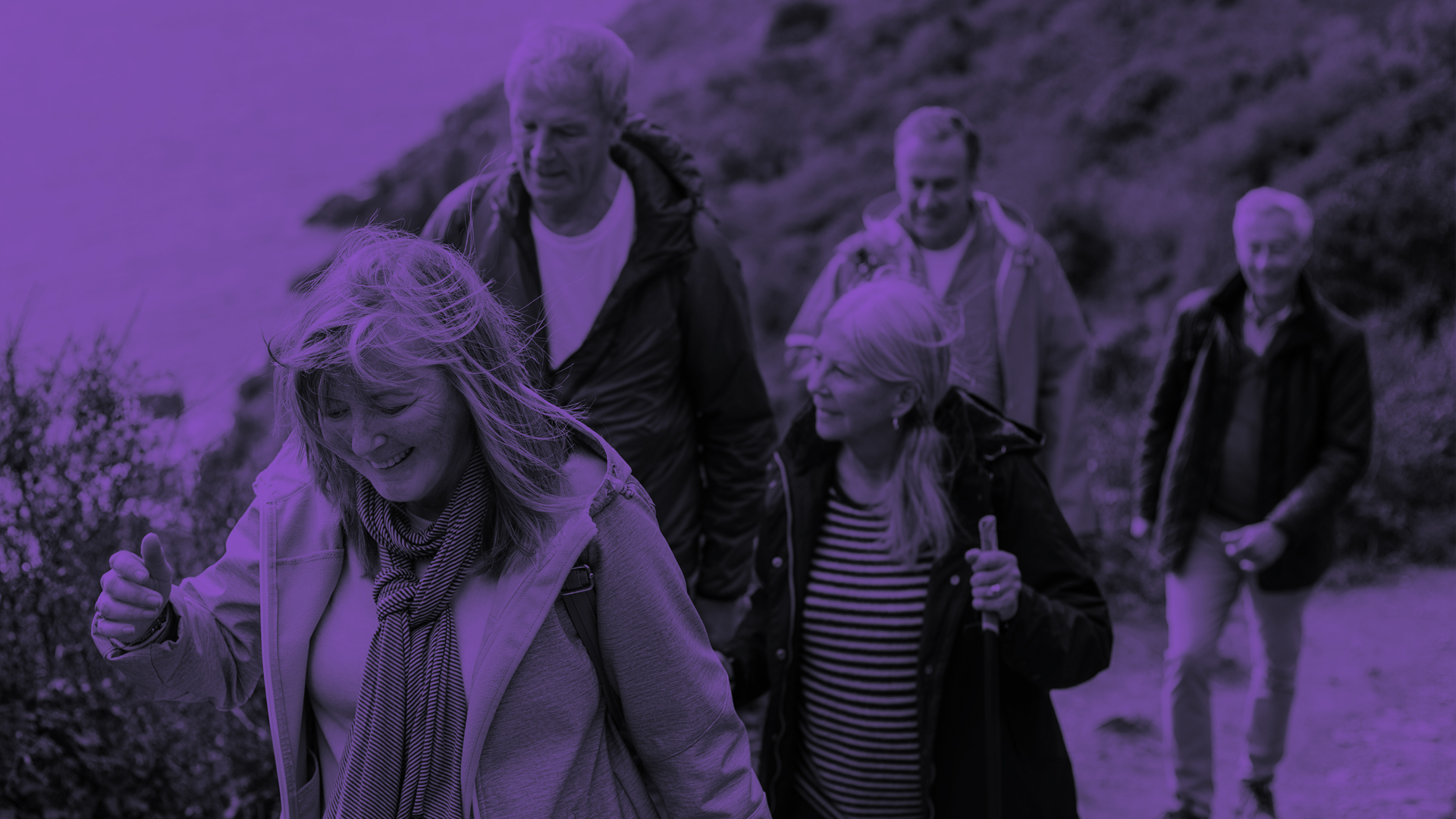
Focus on review articles
The effect of interventions anticipated to improve plantar intrinsic foot muscle strength on fall-related dynamic function in adults: a systematic review. Willemse, L., Wouters, E.J.M., Bronts, H.M., Pisters, M.F., Vanwanseele, B. J Foot Ankle Res 15:3 (2022)
Systematic reviews are a vital source of information that appraises the literature and brings together the most recent evidence related to a particular subject. The Journal of Foot and Ankle Research (JFAR) has recently published three high quality review articles, which we are sharing as part of a three-part series each month.
Below is the second review summary in this series. We recommend reading the entire article to get a deep understanding of the literature, which can be accessed for free here.
There is only limited evidence that strengthening of plantar intrinsic foot muscles improves falls-related foot function
Every year, approximately one third of all adults over 65 sustain a fall at least once, with one third of all falls resulting in serious injury. Altered gait and balance deficits are common and a strong determinant of falling in older people. One factor that is believed to contribute to altered gait and balance is the decreased force-producing capacity of plantar intrinsic foot muscles in older adults. Strengthening of the plantar intrinsic foot muscles has been found to be effective in the treatment and prevention of conditions such as plantar fasciitis. However, it is not known how such a training program may influence falls related dynamic activities.
This systematic review by Lydia Willemse and colleagues aim to provide insight into the evidence related to strengthening of plantar intrinsic foot muscles on balance and gait.
An initial search of the literature found 9198 records which was subsequently reduced to 11 studies that met the inclusion criteria. The overall quality of the included studies was low, and only five studies were of adequate quality to allow for data to be included in the review. This indicates that little is known about the effects of plantar intrinsic foot muscles strengthening on fall-related dynamic function.
The data that was able to be included was from studies with small sample sizes, and generally included strength training programs performed by young participants. The data revealed low certainty evidence for the beneficial reduction in vertical ground reaction force impulse during running. Further, very low evidence indicated that strengthening of plantar intrinsic foot muscles improved balance. However, there was risk of bias and uncertainty about measurement equipment in the studies that produced these data.
This review found that there was, at best, low certainty evidence that strengthening of plantar intrinsic foot muscles improves dynamic foot function and balance control. There is a need for high quality studies that aim to investigate the effect of functional strengthening exercises for the plantar intrinsic foot muscles in large samples of older people.
Read the full study here.
Cortisone injections explored up close

Focusing on the positives
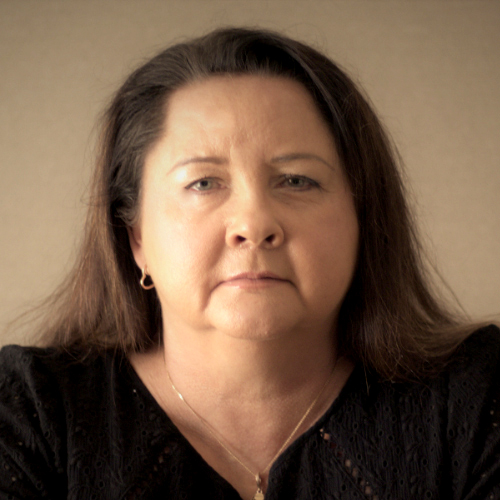
Dr Bergin also has a strong background in clinical education and Quality and Risk management and she is currently working as a Lecturer in the Discipline of Podiatry at La Trobe University, and part-time in the disability sector as a Risk Management Investigator. In 2009, she was awarded a PhD in Health Services Research from Monash University and her thesis was on: ‘Community-based models of care for management of diabetes-related foot complications: current and future models of care’. To this day, Dr Bergin is still very active in the research sector, and her current interests include the influence of psychosocial elements on outcomes for chronic disease; including diabetes-related foot disease.
Shan Bergin, Chair of the Australian Podiatry Education and Research Foundation reflects on the positive work of podiatrists and in doing so, shares some good news with members that benefits podiatrists.
The COVID pandemic has caused much disruption to the podiatry workforce over the past two years. This disruption has been significant regardless of whether you work in the public or private sector, work primarily in academia and education; or do a combination of all of the above. Our work-related activity was also heavily impacted by changes to schooling, for those of us with school-aged children, and the limitations placed on all of us in terms of movement and lifestyle.
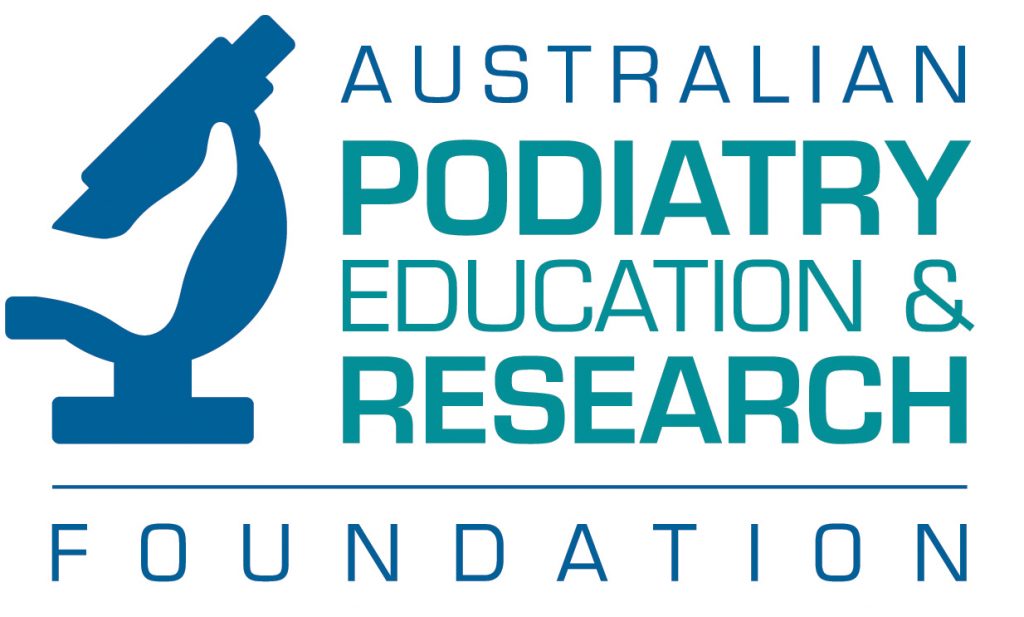
Firstly, the Board of Trustees at APERF would like to congratulate Kristin Graham and her co-researchers on the completion of their APERF funded study: Prescribing practices in Australian podiatrists and barriers and facilitators to endorsement for scheduled medicines, and the subsequent publication of this research in the Journal of Foot and Ankle Research. If you haven’t already read this piece of work, you can find the article freely accessible here.
This high quality study and publication informs an important area of podiatric practice and is relevant to all members of our profession. From an APERF perspective, it is exciting for us to see APERF-funded research published and contributing to the ongoing evolution of podiatry.
APERF would also like to take this opportunity to congratulate our successful funding applicants for 2021.
Congratulations to:
- Dr Helen Banwell – Does the use of textured insoles improve gross motor measures balance domain outcomes in children with motor skill difficulties when compared to footwear alone. A multi-site feasibility trial.
- Polly Lim – Efficacy of foot orthoses for midfoot arthritis.
- Professor Shannon Munteanu – Development of the Podiatry Employer Satisfaction Survey (P-ESS): a survey to measure employer satisfaction of podiatry graduates.
- Dr Peta Tehan – Addressing inequity in diabetic foot disease in Australia – understanding public podiatry services for Australians with or at risk of diabetic foot disease across Australia.
- Dr Glen Whittaker – Diagnostic accuracy of clinical features for the early identification of systemic inflammatory causes of heel pain.

Exciting developments are underway
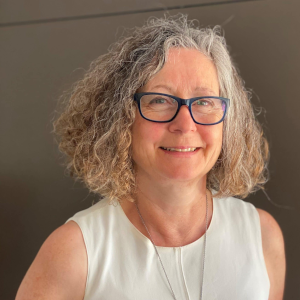
Associate Professor Caroline Robinson is the Associate Head School of Allied Health, Exercise and Sports Sciences (SAHESS) and the Sub Dean Learning and Teaching, Faculty of Science and Health, Charles Sturt University (CSU). Caroline has a particular interest in healthy ageing, First Nations curriculum, and pharmacology. Caroline is the inaugural Chair of the Australasian Council of Podiatry Deans, collaborating with the Podiatry Program Leaders in Australia and New Zealand to provide an important voice for podiatry educators and enabling a coordinated approach to education initiatives and issues that affect podiatry courses and student education.
We asked Associate Professor Caroline Robinson to share the latest news from the Australasian Council of Podiatry Deans (ACPD), along with advice for podiatrists on how to get involved.
What has been happening recently in and around the ACPD?
At this time of year, universities across Australia and New Zealand have recently welcomed a new cohort of podiatry students. A majority of these new students are graduates from high school and a small minority are non-school leavers (formerly known as ‘mature-aged’ students).
The approximate intake across the eight active undergraduate podiatry programs in Australia is 280 students.
It is concerning that podiatry continues to attract a much smaller number of new students than other undergraduate allied health programs, and it’s not uncommon to have several aspiring physiotherapists in the class. Fortunately, these new students who thought physiotherapy was their path, tend to thrive in first year and realise that podiatry is a fascinating discipline with many and varied career paths.
Podiatry students, however, understand the need to educate family and friends about their career choice. It is important that we equip new students with the knowledge and language to explain that the word ‘podiatrist’ derives from the Greek words ‘pod’ – meaning foot – and ‘iatros’ – meaning physician. A ‘foot doctor’ is an essential member of any multi-disciplinary healthcare team, because good foot health enables mobility and physical activity to reduce the risk of chronic disease and enhance mental wellbeing.
All podiatrists should take an active role in advocacy for our discipline and promote podiatry as a possible career path not only to prospective students but also to the broader community. This is core business for academic staff in universities but we rely on our partners in industry to collaborate in building the future podiatry workforce.
Positive developments are underway, however, including the following updates.
- The growth in the number of registered podiatrists from December 2020 to December 2021 was 5.2%, which was higher than the proportional increase in registered physiotherapists during the same period (3%).
- The ACPD completed a cross-institutional pilot study in 2021, to understand undergraduate students’ choices to study podiatry. Dr Michelle Kaminski presented preliminary findings at the APodA’s, Australian Podiatry Conference 2021 – ‘Why do people choose to study podiatry?’ The main study was launched early in 2022 to seek feedback from podiatry students and comparative data from other allied health students. These online forums are currently in progress and will provide valuable data about the factors which influence prospective students’ enrolment and career pathway choices.
- The ACPD collaborated with the APodA in 2021 to develop a marketing strategy which will inform course promotion activity in universities this year. The APodA is responsible for the development of resources and campaign project management; podiatry departments will collaborate with the APodA to develop and co-brand assets for use in high schools and course marketing events.
How can podiatrists support these developments?
- Promote the Foot Health Australia site in online media and share public-facing assets developed by the APodA through your clinic and social networks.
- Reach out to one or more of the podiatry schools to discuss opportunities to collaborate in student recruitment – it’s a great way to boost your CPD hours for the year!
- Help to illustrate the holistic impact of podiatry in your local community by sharing news updates and other sources. As just one example, this news report shows that physical activity is often prescribed as a form of treatment to slow down the progression of neurodegenerative disorders such as Alzheimer’s and Parkinson’s disease.
What’s next on the horizon for the ACPD?
The ACPD will continue its work this year to advocate for podiatry at a national level, through the Chairs of Allied Health Councils joint forum. In addition to the work on student recruitment, ACPD members are collaborating on a range of projects including:
- The development of a national standardised clinical assessment tool
- Inter-institutional benchmarking
- Broadening the membership of ACPD
- Enabling a competitive funding source for education-related research projects.
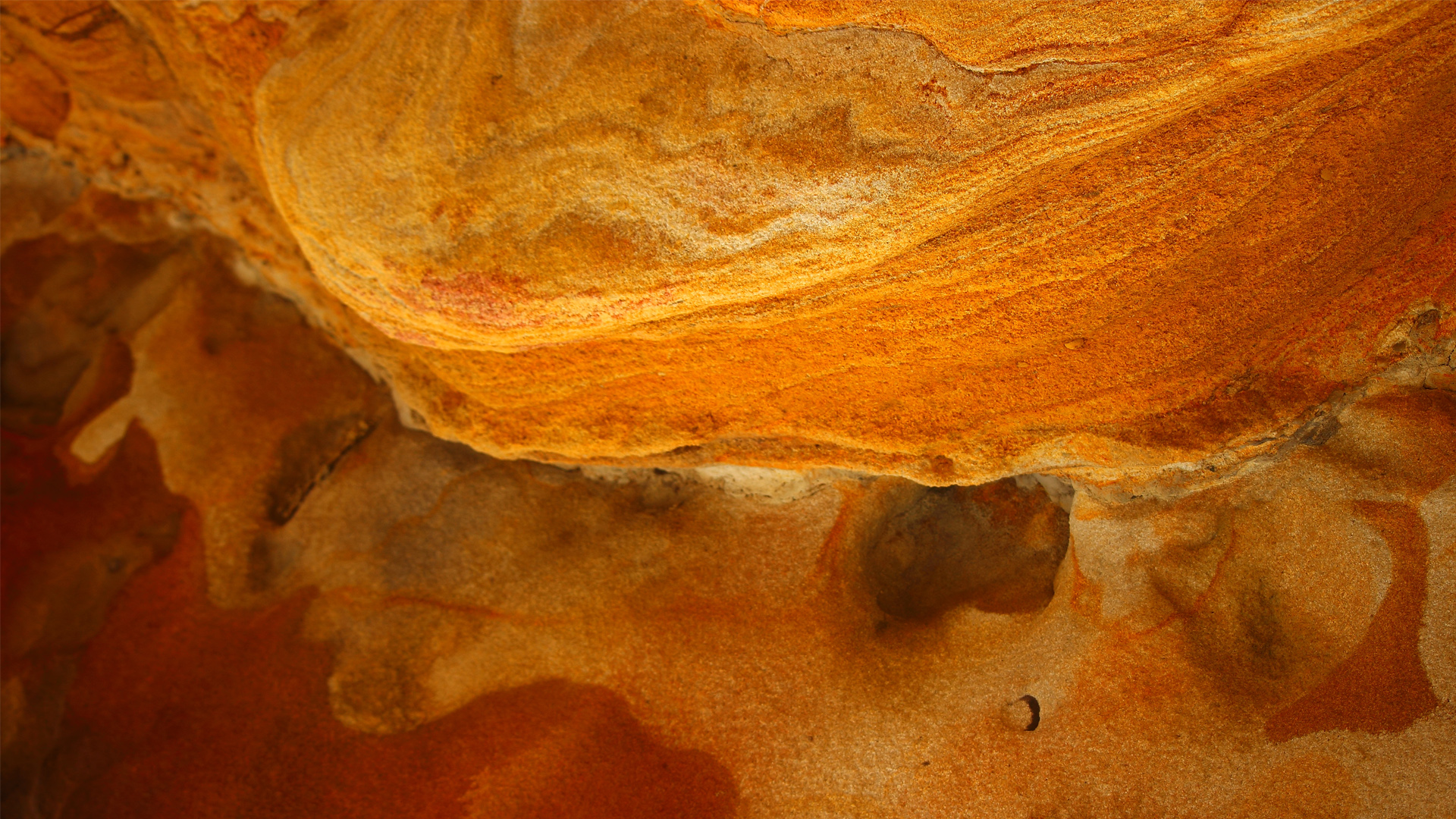
Much more than material aid

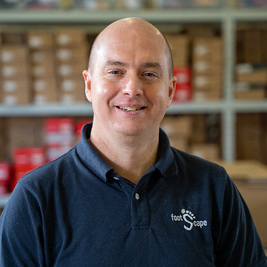
James lectures at La Trobe University within the Discipline of Podiatry and is a current University of Newcastle PhD candidate, involved in research giving First Nations voices to foot health education, and the developing, delivering, and evaluating of cultural safety education for undergraduate podiatry students. James also works as a Project Podiatrist part-time at Central Australian Aboriginal Congress and is Vice president of Footscape in 2022.
Since completing his Bachelor of Podiatry at La Trobe University in 2000 Anthony Lewis has worked in a range of Australian healthcare settings serving marginalised population groups predisposed to foot pathology. Observing the startling implications of debilitating foot pathology upon the most vulnerable has motivated Anthony to establish Footscape. Anthony has completed further post graduate studies extending to a Master of Public Health at Flinders University and Graduate Certificate in Wound Care at Monash University.
This month new Footscape Vice President James Gerrard joins Anthony Lewis to share some updates on Footscape’s work with a culturally safe podiatry clinic on Wiradjuri Country at the Wellington Local Aboriginal Land Council.
During 2021 Dr Matthew West (Wiradjuri), Professor Viv Chuter, James Gerrard, and the Wellington Local Aboriginal Land Council first applied to Footscape for material aid items on behalf of a culturally safe podiatry clinic.
The background
To give some background on this clinic’s establishment, led by an Aboriginal podiatrist, the following excerpt is taken from West et al. (2021).
‘The culturally safe podiatry clinic is designed to create an environment that is considerate of the spiritual, physical, social, and emotional world view of Aboriginal and Torres Strait Islander Peoples, thereby creating a clinical experience which is conducive to, and supportive of, the specific needs of this community. Additionally, the approach to the management of clients within this clinic is one that recognises the importance of culture, family, and community for Aboriginal and Torres Strait Islander Peoples.
For example, clinical consultations are structured around group appointments and two intake times, as opposed to a traditional individual appointment time. This collective-participation approach encourages open discussion amongst community members, assisting students in understanding lived experiences and history sharing, and creates a sense of ownership of the clinic for Aboriginal and Torres Strait Islander Peoples.
The clinic provides a range of podiatry care and health promotion education, with a focus on diabetic [related] foot disease and prevention education.’
The material aid that Footscape provides to this clinic consists of footwear, socks, and foot care kits. These items compliment the clinical and culturally safe service by enabling display and distribution of items. Clinically, the evidence around the role of indicated footwear in the treatment of a variety of presenting pathologies is well known, as are the benefits of foot care kits in diabetic foot self-care.
More than material aid
The Footscape material aid starts conversations too: between Community, between podiatrist and client, and between podiatrists and Community. Conversations range from footwear styles, function, purpose, and the ability to house orthoses. Together, these conversations help to educate patients and promote informed and self-determined choices for school, sporting, recreational, work, and personal use.
But these conversations turn into yarns too, exemplifying two-way learning. Podiatrists learn more about local culture and First Nations’ perspectives of foot health, and podiatrists learn about Country people like to get out on, and importantly, some Truth-telling.
Space for humility and learning
Clinical yarning like this in a culturally safe space teaches practitioners about protective health factors for people in the area, such as social connectedness, Country, culture, and spirituality.
Cultural humility in this setting brings respect for a cultural identity other than your own and makes you reflect on your own biases, beliefs, and thoughts on social justice in healthcare. Discussing foot health shares stories of strength and resilience and promotes collaborative partnerships and shared decision making. Entering this space with material aid, you think it may have a place in treatment planning; yet in leaving, you learn that culture is healing.
The Footscape material aid in this space demonstrates reciprocity, it promotes foot health awareness, and importantly, it can position the podiatrist as the learner. It leads to positive healthcare experiences, collaboration, shared learning and therefore – improved foot health outcomes.

Workplace policies and procedures for the new ‘COVID-normal’

Kain Hourn emphasises the need for robust policies and procedures when adapting to the new COVID-normal in Australia.
As Australia attempts to live with COVID-19 rather than eradicate it, workplaces across the country are facing challenges unlike any they have faced before. This has been exacerbated by the spread of the Omicron variant, with high community transmission forcing businesses to remain agile to avoid crippling disruption. From a staffing perspective, one of the key challenges is, and likely will continue to be, the management of day-to-day disruptions caused by COVID-related staff absences. While there is no magic formula to help businesses overcome this challenge, workplace policies and procedures have never been more important.
Why are workplace policies and procedures important?
Policies and procedures ensure consistency and a level of certainty when dealing with the everyday happenings of a workplace. During a crisis like the one we are experiencing now with COVID-19, consistency and certainty are critical. When a staffing issue arises, workplaces need to act quickly to ensure there is as little disruption as possible. This is achieved through the degree of certainty a policy and/or procedure provides. Take the following scenario as an example:
Example
A staff member contracts COVID on their day off and is unable to come to work the next day. With a clearly defined personal/carer’s leave policy, the employee knows who to notify (e.g. their manager), how soon they need to notify that person (e.g. as soon as possible before their next shift) and any other information they have to provide to that person (e.g. how long they expect to be absent, evidence requirements and so forth)
It is vital that an issue like the above is dealt with in the same way that previous instances of the same or a similar nature were dealt with. This will help avoid feelings of frustration or even favouritism among staff members, so that the situation is always managed according to the same procedure (regardless of who is affected).
In essence, having a relevant policy and procedure will automate the response to a particular issue, which in turn saves time and helps a business get on with business.
How to ensure effective development of policies and procedures
To ensure policies and procedures continue to achieve their intended purpose, it is important to regularly review and (if required) update them.
Regular monitoring and maintenance of policies and procedures allows them to remain relevant in a volatile market, and also ensures any outdated or unhelpful practices are removed. Remember, policies and procedures are all about creating consistency and certainty to keep a business running effectively. If a policy or procedure is still relying on practices that are outdated, it will likely not achieve what it was designed to achieve.
Once a policy or procedure has been developed or updated, it is vital to train all staff members about the policy/procedure. Policies and procedures are useless if staff don’t know they exist or are unsure how they apply. Regular training will help to remove this ambiguity.
A note of practical advice on storage
Finally, workplace policies and procedures should be kept in two separate manuals:
- A Human Resources ‘policies and procedures manual’; and
- A ‘Work (Occupational) Health and Safety’ manual
These manuals should be easily accessible to all staff members (whether in hard or soft copy).
Which procedures are important for the new COVID-normal?
When managing the new COVID-normal, the following policies and procedures are important to maintain and follow.
- Leave policies (including personal/carer’s leave and annual leave)
- Relevant ‘Work (Occupational) Health and Safety’ policies (including a COVID safety plan)
- Working from home/remote working policy
- COVID-19 vaccination policy (if applicable)
The APodA’s HR Service has a suite of sample policies and procedures (including those related to COVID) available in our online resources portal for members.
The final word
There is no secret tonic to guide workplaces through this new phase of the pandemic, but being consistent through the use of strong and relevant workplace policies and procedures will help.
For more information about this article, please contact the APodA HR Advisory Service on 1300 620 641 or email hrhotline@podiatry.org.au.




